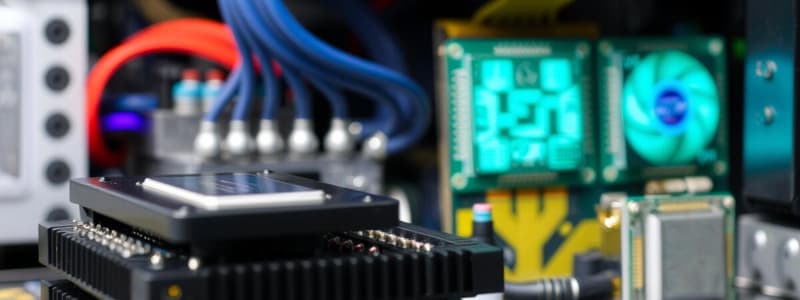Podcast
Questions and Answers
What function does the control unit of a CPU primarily serve?
What function does the control unit of a CPU primarily serve?
- It directs the operation of the processor. (correct)
- It performs arithmetic calculations.
- It manages communication between input and output devices.
- It stores data temporarily.
Which type of computer is primarily designed for specific applications, typically optimizing performance for those tasks?
Which type of computer is primarily designed for specific applications, typically optimizing performance for those tasks?
- Mainframe computer
- Embedded system (correct)
- General-purpose computer
- Supercomputer
Which component of a computer system is primarily responsible for interfacing with peripheral devices?
Which component of a computer system is primarily responsible for interfacing with peripheral devices?
- Arithmetic Logic Unit (ALU)
- Control Unit
- Graphics Processing Unit (GPU)
- System Bus (correct)
What is the primary characteristic that differentiates a supercomputer from other types of computers?
What is the primary characteristic that differentiates a supercomputer from other types of computers?
In the context of AI, which of the following best describes the function of machine learning?
In the context of AI, which of the following best describes the function of machine learning?
Flashcards are hidden until you start studying
Study Notes
Computer System
- Definition: A computer system is a combination of hardware and software designed to process data and perform tasks to meet user needs.
- Characteristics: Includes speed, accuracy, automation, versatility, and storage capacity.
- Applications: Used in various sectors such as education, healthcare, business, gaming, and scientific research.
- Functions: Perform inputs, processing, storage, and output of data.
Basic Organization of a Computer
- Composed of input devices, processing unit (CPU), memory (RAM/ROM), storage, and output devices.
- Input Devices: Keyboard, mouse, scanners; facilitate user interaction with the computer.
- Output Devices: Monitors, printers; display or produce results.
CPU and Its Components
- Central Processing Unit (CPU): The brain of the computer, responsible for executing instructions and processing data.
- Components:
- Arithmetic Logic Unit (ALU): Performs arithmetic and logical operations.
- Control Unit (CU): Directs operations of the CPU and coordinates between hardware components.
- Registers: Small storage locations that hold temporary data and instructions.
Units of Memory
- Memory refers to storage required to hold data and instructions.
- Types:
- Volatile memory (e.g., RAM) loses data when power is off.
- Non-volatile memory (e.g., ROM, flash memory) retains data without power.
- Capacity is measured in bytes (KB, MB, GB, TB).
Control Unit
- Manages and coordinates the activities of the computer.
- Interprets instructions from programs and sends signals to execute them.
- Ensures proper timing for all processes to occur, ensuring the flow of data within the CPU.
Types of Computers Based on Principles of Operation
- Analog Computers: Handle continuous data; used in applications like simulations.
- Digital Computers: Operate on discrete values; applicable for general-purpose computing.
- Hybrid Computers: Combine features of both analog and digital computers for specific tasks.
Types of Computers Based on Configuration
- Supercomputers: Extremely powerful machines used for complex calculations such as weather forecasting.
- Mainframe Computers: Handle large volumes of data for enterprises and institutions.
- Personal Computers (PCs): Designed for individual use; accessible and versatile.
- Workstations: High-performance PCs optimized for technical or scientific applications.
- Servers: Provide resources and services to other computers over a network.
Overview of Communication Technologies
- Encompasses tools and systems that enable data transmission over distances.
- Types:
- Wired communication (e.g., fiber optics, Ethernet cables) for reliable connections.
- Wireless communication (e.g., Wi-Fi, Bluetooth) for flexibility and mobility.
- Technologies support data transfer, internet connectivity, and networking across devices.
AI Basics
- Artificial Intelligence (AI): Simulation of human intelligence processes by machines, especially computer systems.
- Key Components: Machine learning, natural language processing, and robotics.
- Applications: Widely used in areas such as speech recognition, image processing, and autonomous systems.
Studying That Suits You
Use AI to generate personalized quizzes and flashcards to suit your learning preferences.




